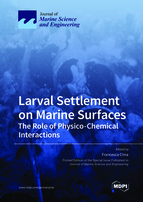Larval Settlement on Marine Surfaces: The Role of Physico-Chemical Interactions
A special issue of Journal of Marine Science and Engineering (ISSN 2077-1312). This special issue belongs to the section "Marine Biology".
Deadline for manuscript submissions: closed (31 May 2022) | Viewed by 29799
Special Issue Editor
Interests: marine ecotoxicology; marine biofouling; antifouling systems; marine invertebrate immune system; comparative immunobiology; immunotoxicity; embryotoxicity; evolutionary biology of tunicates
Special Issue Information
Dear Colleagues,
The ecological succession of the fouling community in coastal marine ecosystems depends on interactions among organisms and hard substrate. The primary fouling is formed of organisms that settle mainly on virgin surfaces. The secondary fouling is represented by organisms that need fouling for their settlement and growth. In all cases, there is a very close relationship between larval settlement and type of substrate.
In this Special Issue, I call for reviews and original research papers that pay attention to various aspects of the evaluation of marine larval settlement on both natural and artificial surfaces, pro-fouling and anti-fouling systems enclosed, with the growing interest in eco-engineering for coastal ecosystem preservation.
Results on inter- and intraspecific competition for substrate; the dominance of invasive species; the effects of color, roughness, wettability, hydrophilicity, oleophilicity, and nanostructure of the substrate; tolerance to repellent substances; and the morphology of adhesive structures are welcome.
Assoc. Prof. Francesca Cima
Guest Editor
Manuscript Submission Information
Manuscripts should be submitted online at www.mdpi.com by registering and logging in to this website. Once you are registered, click here to go to the submission form. Manuscripts can be submitted until the deadline. All submissions that pass pre-check are peer-reviewed. Accepted papers will be published continuously in the journal (as soon as accepted) and will be listed together on the special issue website. Research articles, review articles as well as short communications are invited. For planned papers, a title and short abstract (about 100 words) can be sent to the Editorial Office for announcement on this website.
Submitted manuscripts should not have been published previously, nor be under consideration for publication elsewhere (except conference proceedings papers). All manuscripts are thoroughly refereed through a single-blind peer-review process. A guide for authors and other relevant information for submission of manuscripts is available on the Instructions for Authors page. Journal of Marine Science and Engineering is an international peer-reviewed open access monthly journal published by MDPI.
Please visit the Instructions for Authors page before submitting a manuscript. The Article Processing Charge (APC) for publication in this open access journal is 2600 CHF (Swiss Francs). Submitted papers should be well formatted and use good English. Authors may use MDPI's English editing service prior to publication or during author revisions.
Keywords
- Larval settlement
- Hard-substrate community
- Biofouling
- Marine invertebrates
- Substratum preference
- Artificial surfaces
- Invasive species selection






